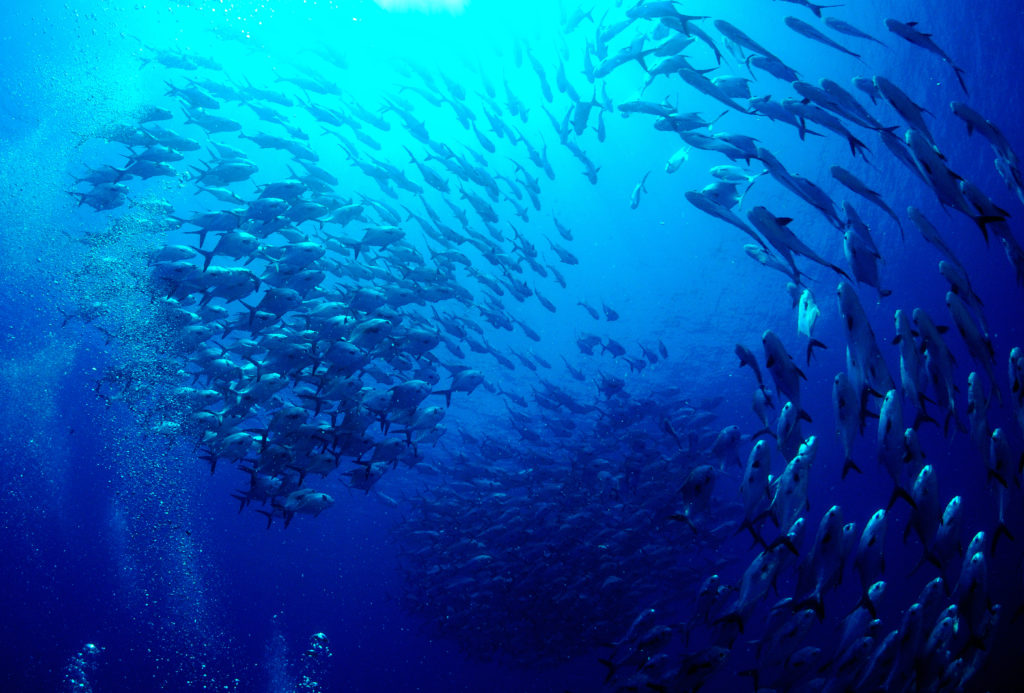This article appears in the current issue of the Bonefish & Tarpon Journal. (Photo: Dr. Jiangang Luo)
Ross Boucek, Ph.D.
Florida Keys Initiative Manager, Bonefish & Tarpon Trust
Jacob Brownscombe, Ph.D
Banting Postdoctoral Fellow, Dalhousie University Research Associate, Carleton University
Benjamin M. Binder
Graduate Research Assistant, Marine Ecology & Acoustics Laboratory, Florida International University
Allowing fish to spawn successfully is one of the most important ways we can ensure a fishery will be sustainable. On the flip-side, the fishing of spawning aggregations can cause a fishery to crash in a very short amount of time. The sharp decline in the population of Nassau grouper in the Caribbean is a sobering example of the adverse consequences of intense aggregation fishing. As fishing of Nassau grouper spawning aggregations became popular, the population dropped so drastically that the fish became an ICUN-listed endangered species. So far, although Nassau grouper spawning aggregations were given protection from fishing, the populations have been slow to recover. In time, it’s hoped that continued prohibition of fishing the spawning aggregations will restore the grouper populations. Obviously, the best conservation approach is to prevent the problem in the first place. Central to Bonefish & Tarpon Trust’s conservation mission is finding where permit, bonefish and tarpon spawn, so we can protect the spawning fish and the habitats they use.
Important goals of Costa’s Project Permit are to identify spawning sites for permit in the Keys and assess the threats those fish may face. From research in the mid-1990s, we know permit migrate off the flats to deeper waters, where they aggregate in the hundreds to thousands in the spring and summer to spawn on reefs and wrecks. At the aggregations, catch rates are high, with anglers often catching 10 to 15 permit a day. In the Florida Keys, even though permit are protected from harvest during their spawning season, a popular offshore catch and release fishery exists for the species. Angler reports suggest that a high percentage of permit that are hooked at their spawning sites are eaten by predators (mostly sharks) before they are brought to the boat.
To identify where permit are spawning, we are using acoustic tracking. We implant into permit transmitters that send a unique sound pulse that can be detected by hundreds of specialized sensors spread throughout the Keys. This technology provides scientists with detailed day-to-day movements of permit on the flats and offshore on the reef tract. To date, we have tagged over 140 fish and followed them to their spawning sites. From our tracking work, we discovered that there are quite a few places where the flats fish spawn. However, one place, known as Western Dry Rocks, is an especially important spawning site because so many flats permit go there to spawn. More fish migrated off the flats to spawn at Western Dry Rocks than any other place we found. As such, fishing at Western Dry Rocks, if there are sharks around, could have a significant impact on the permit fishery.
We think that permit spawn at Western Dry Rocks because of the ocean currents that carry the larvae after the adults spawn. At Western Dry Rocks, irregular ocean currents exist called the Pourtales Gyre. This gyre keeps larvae out of the Gulf Stream and instead circulates them back into the Keys. So, the permit that spawn at Western Dry Rocks have a better chance of their larvae staying in the Keys, and the resulting juveniles growing up in the Keys, compared to if they spawn in places like Marathon or Key Largo.
The second phase of this research is to assess the threats permit experience at the Western Dry Rocks aggregation. Over the last two years, with the help of expert light-tackle captains, our scientists fished Western Dry Rocks for permit. With various underwater cameras and other equipment, they determined that, on average, 39 percent of hooked permit were eaten by sharks before they could be landed. These numbers raised warning flags, as mortality rates of 20 percent for other fish similar to permit can trigger significant population declines. Research continues to refine the permit mortality rates and the impacts, if any, of the offshore angling.
In summary, protecting spawning fish is essential to ensuring a productive fishery in the future. Unlike grouper and snapper that are harvested at their spawning aggregation sites, permit are lost due to predation in a catch and release fishery; but whether harvested or eaten by a shark, the fish is lost from the population. Reducing mortality within a catch and release fishery may necessitate new management approaches, which are needed to conserve the fishery. We expect the data from this research project to be applied to the ongoing Florida Keys National Marine Sanctuary management plan revision process.




